The Bali Temple Explorer - Text-and-photo Version |
|
The Bali Temple Explorer is an interactive film website which shows a group of three small temples on the island of Bali, in Indonesia. This is the text-and-photo version of the site. The three temples are in the village of Bedulu, about four miles south of the town of Ubud, in central Bali. The photos show them as they were during a temple festival in August 2010. Here is a picture of the first temple from far away... 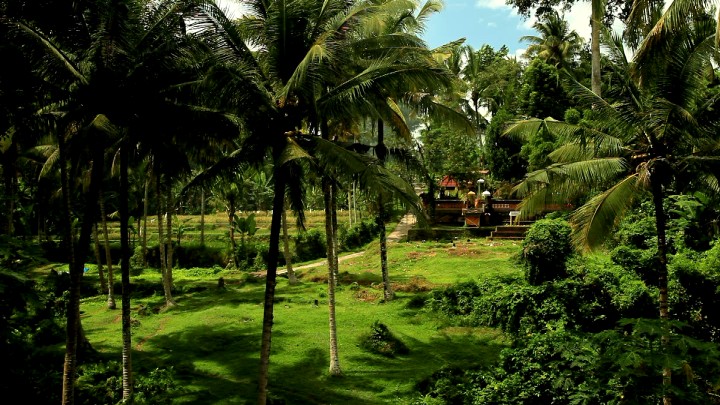
And here is the temple a bit closer up... 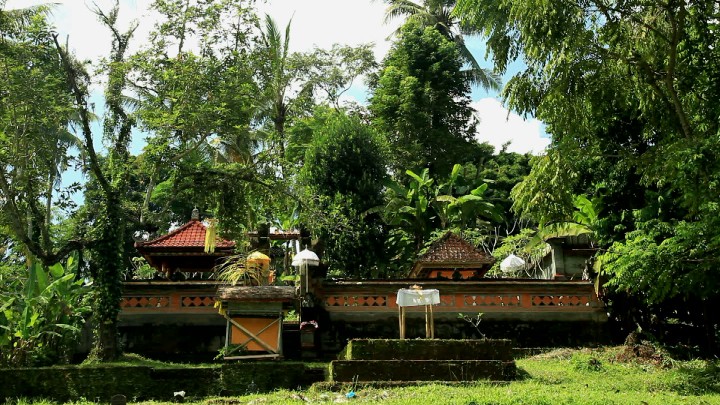
This temple is one of a group of three small temples – we'll see the other two temples later. This particular temple is called "Pura Dalem Marajapati" and it is dedicated to the Balinese guardian of the dead. It is often used for funeral ceremonies, and the land in front of it is used for cremation. However, the event taking place now is not a funeral – it is an "Odalan", a regular temple festival that takes place twice a year. Let's look at the entrance to the temple... 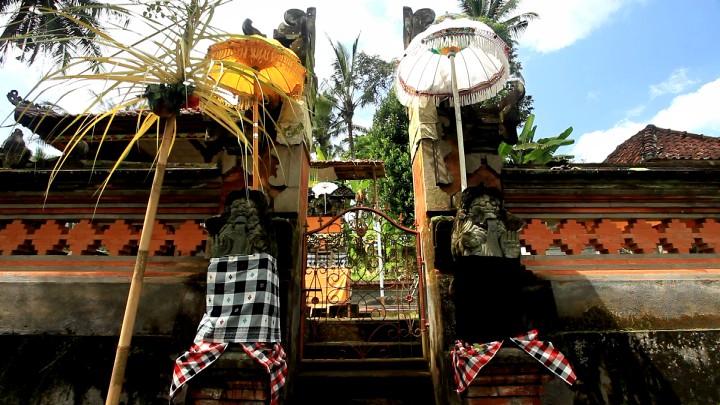
One of the most distinctive features of a Balinese temple is its "split gate" or "Candi Bentar". Often you will find two fierce-looking figures in front of such a gate. At this temple, the figures in front of the gate are probably "leyaks" – witch-like followers of Rangda, the Balinese queen of the demons. One of the priests at this temple is Bapak Mangku Beji. He describes the purpose of these two figures like this: Bapak Mangku Beji: If you visit a Balinese temple, you will usually find two large figures in front of the entrance. Each figure has a ferocious face and angry eyes. Balinese people believe that these figures act as guardians for the temple, and that they protect it from evil. Each guardian figure is protected by an umbrella and has cloth wrapped around it. In Bali, umbrellas are often used to mark out sacred or important objects or people. And pieces of cloth like the ones on these figures are commonly used to wrap important statues, shrines and trees – and they are often worn by people who are thought to have spiritual power. The black and white checked cloth worn by the figure on the left is called "poleng". Its pattern reflects Balinese dualism – the idea that opposites need each other to exist. For example: day and night, low and high, bitter and sweet. Balinese believe that balancing these opposites brings prosperity and peace. At the foot of each figure is a small offering of rice. Let's look at it more closely... 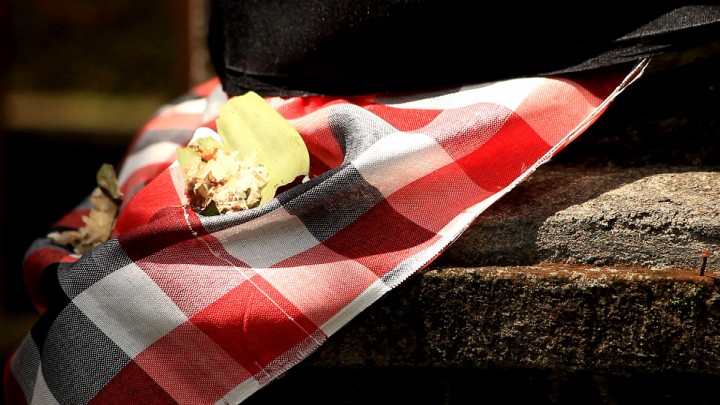
In Bali, small offerings are often left to the unseen inhabitants of the landscape – deities, demons and the spirits of ancestors. Places like gateways, that divide one area from another, are important spots for these offerings – and this is a typical example. Let's go through the gate and enter the first temple... 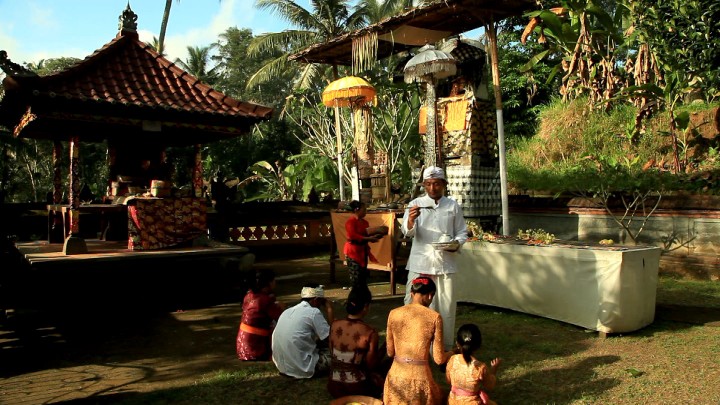
Now we are in the first temple, and we can see some people praying. They are taking part in an "Odalan" or temple festival. Pande Nyoman is a musician and dancer who lives nearby, and is a member of the temple. Here's how he describes this festival: Pande Nyoman: This is very special time for us in the village and also for the god that we honour in the temple. This festival is almost like a party in honour of this god, a bit like a birthday party. So people who are members of the temple come and pray, and they give something to the god. It's a way to say thank you. In this ritual, members of the temple kneel and pray. Bapak Mangku Beji, a priest at the temple, explains how people pray here. Bapak Mangku Beji: When a temple has a festival or "odalan", everyone who is a member of the temple will come to worship here. In Bali, when we worship we usually raise our hands five times. First, we do it with empty hands.
After praying, the worshippers receive holy water from the priest, who pours it for them to drink and sprinkles it on them. The holy water serves to purify and bless the devotee. Holy water plays a role in almost all Balinese rituals. In front of the people praying, there is a shrine, and also a table which is covered with baskets. Let's look at the baskets more closely... 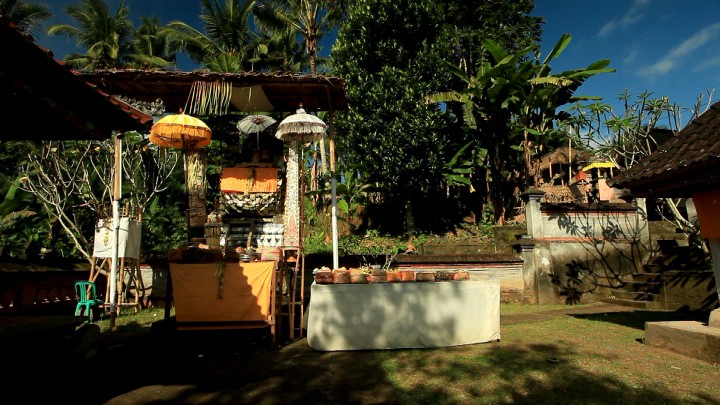 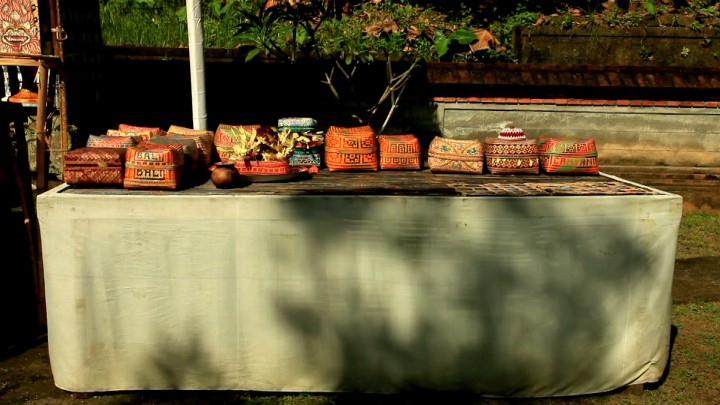 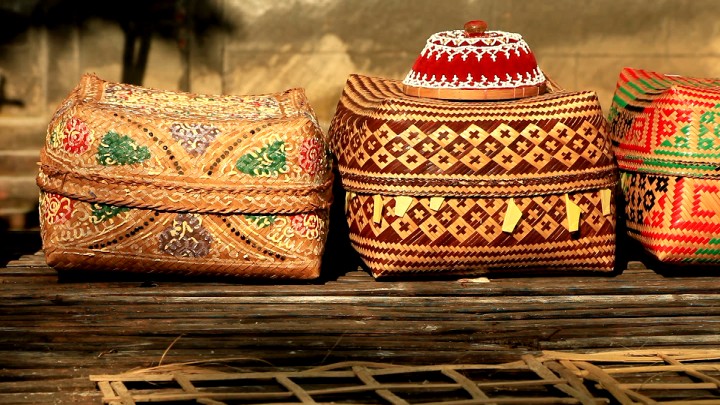
This is what Pande Nyoman has to say about these baskets. Pande Nyoman: Baskets like these are offerings to the temple. They are brought in by the women of the village. There are many kinds of offerings, from big to small – these ones are medium size. Inside the basket, you can find fruit and vegetables. These offerings are to say "thank you" to the god we worship at the temple. On the right of the table, we can see some stairs – let's go up them... 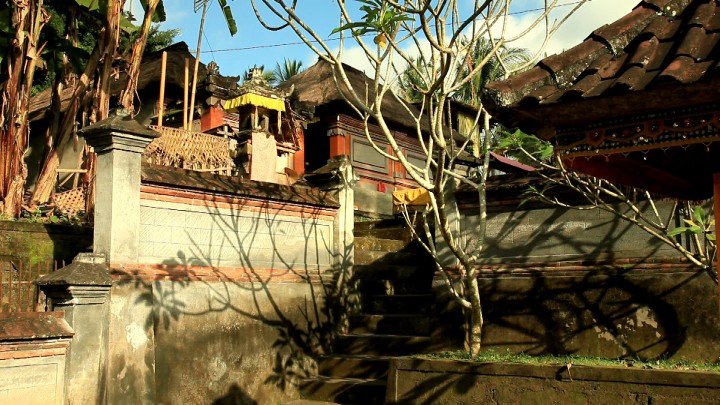
At the top of the stairs, we can hear the sound of music playing. The sound comes from a small pavilion in front of us. Let's go and see who's playing the music... 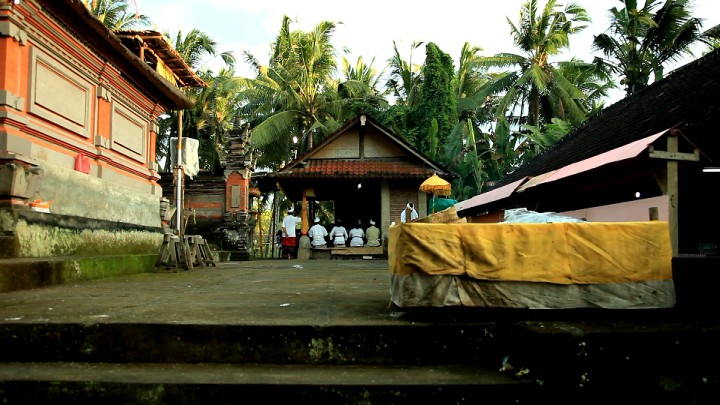
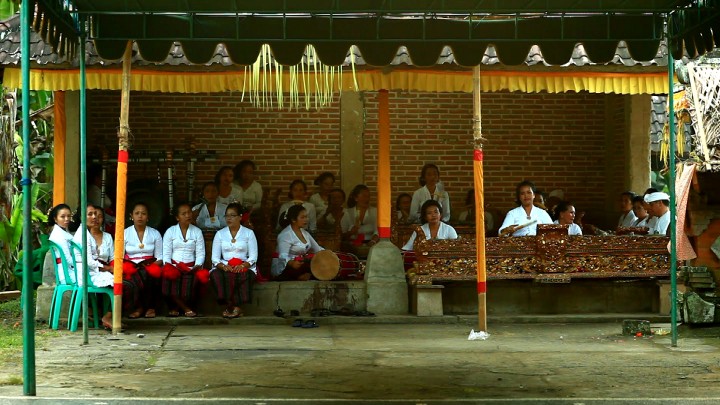
We can see a group of about 20 women. They are playing a "Gamelan". This is a musical ensemble, generally made up of drums, gongs, xylophones and metallophones. There can as few as two instruments in a gamelan – or as many as 60! The first woman's gamelan group was founded in 1980. Although there are far more men's gamelan groups, women's groups have gained popularity in recent years. Let's walk past the gamelan and see what's there... We walk past the gamelan and turn left. We can now see the entrance gates to the two other temples. 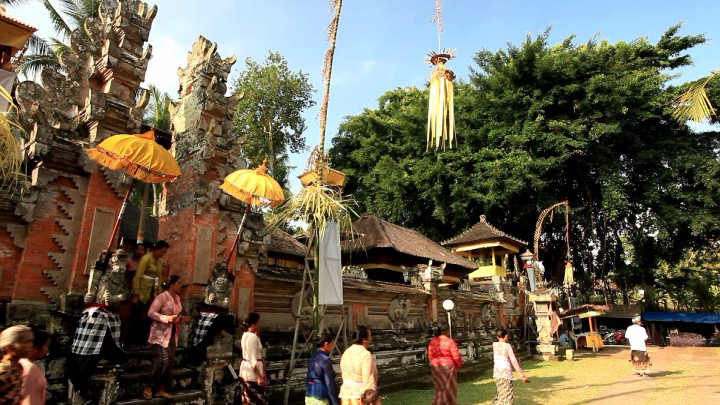 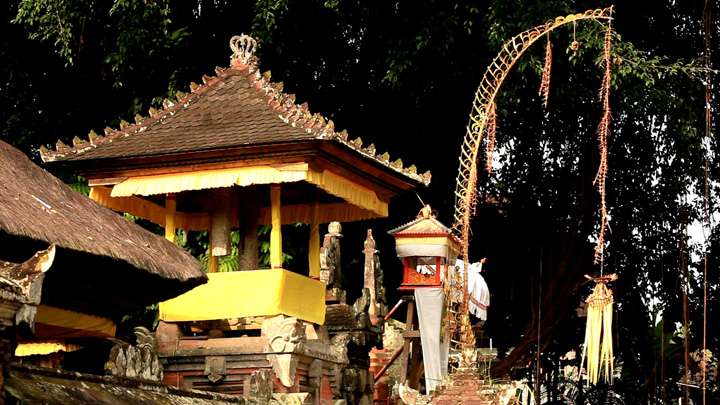
In front of each temple gate we see long swaying tassles. These are part of an offering called a "penjor". This is a long tapered bamboo pole decorated with coconut leaves, supporting a long tassle. At the end of the tassle is a triangular container called a "sanggah cucuk" which holds an offering to the gods. Let's look at the gate to the second temple... 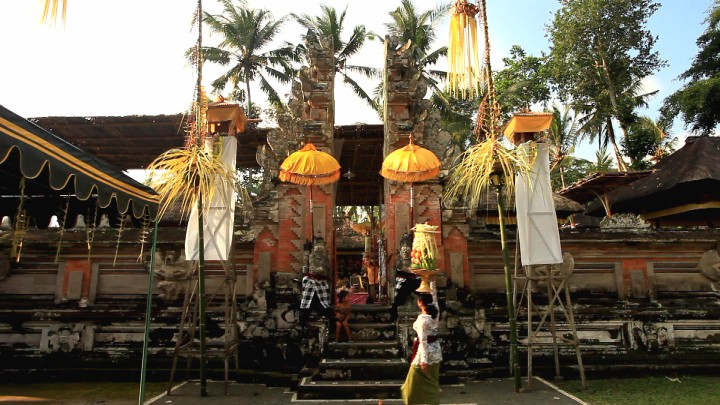
Let's walk through the gate and into the second temple... 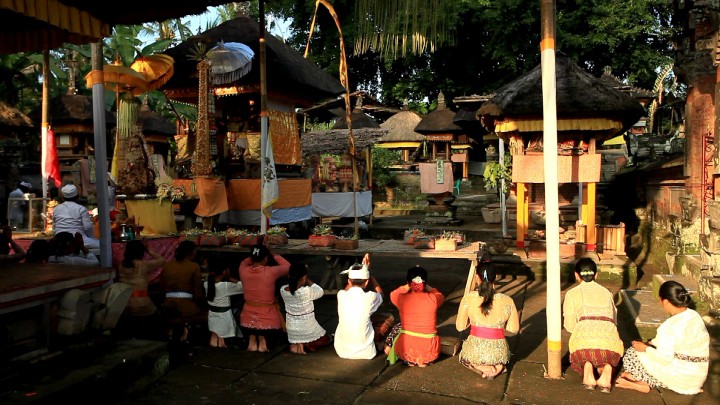
This is the second of the three temples in this group. It is called "Pura Melanting", or the "Market temple", and it is dedicated to the god Sri Sedana. Wayan Sunantara is the leader of the village near the temple. Here is what he has to say about the purpose of this temple... Wayan Sunantara: "Pura Melanting" means "Market Temple"... so here we can ask God for prosperity. But this doesn't just mean prosperity in material things and money. It also means prosperity of the mind. Because the main purpose of religion is not wealth – it is peacefulness. The temple is a holy place where we can ask for guidance on how we should act as human beings. Behind the people praying, we can see a shrine with a small golden carving of the head of a deer... 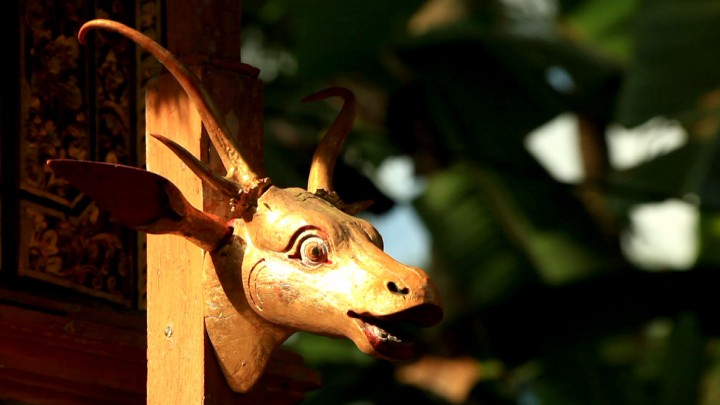
The sculpture of a deer's head shows that this shrine is a "Gedong Maospahit" – a shrine honoring the Majapahit people from Java, whom many Balinese consider as their ancestors. The Majapahit empire ruled much of South East Asia from around 1300 to around 1500. 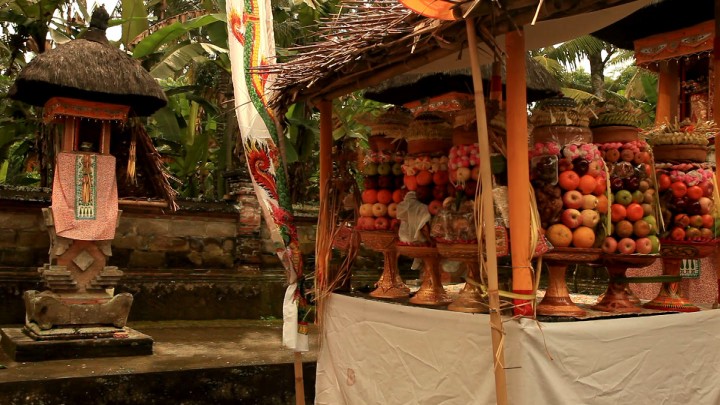
In this temple, we can see some tall offerings of fruit and other food. These look much bigger and more expensive than the baskets we saw in the first temple. We asked Bapak Mangku Beji, a priest at the temple, how much these offerings cost. We also asked whether villagers must make offerings, or whether they are optional. Bapak Mangku Beji: Well, no-one has to make an offering if they don't want to – and the offerings people make depend on how wealthy they are. The richest people in the village will make tall offerings with lots of fruit and other food on them. Those cost about 100,000 to 200,000 Indonesian Rupiah, which is about 10 to 20 dollars. Less well-off people will make offerings that cost the equivalent of about 50 cents to one dollar. And the poorest people in the village will make a kind of offering which is a small square of coconut leaves with some flowers or coins. These usually cost the equivalent of about ten cents to make. But as I said before, no-one has to make an offering if they don't want to. And the important thing is this – when people make their offerings, they should be devoted and sincere. Everyone that we see bringing in offerings is female. Gusti Ayu Sri Suryati is a woman who works as a shopkeeper and trader near the temple. This is what she had to say about preparing offerings for the temple. Gusti Ayu Sri Suryati: At temple festivals, men help to prepare the shrines and make the food. Only women make the offerings that are brought in. Making these offerings is part of my life as a Balinese woman, so I certainly don't expect men to help me make them. Let's move though to the third, "upper" temple... 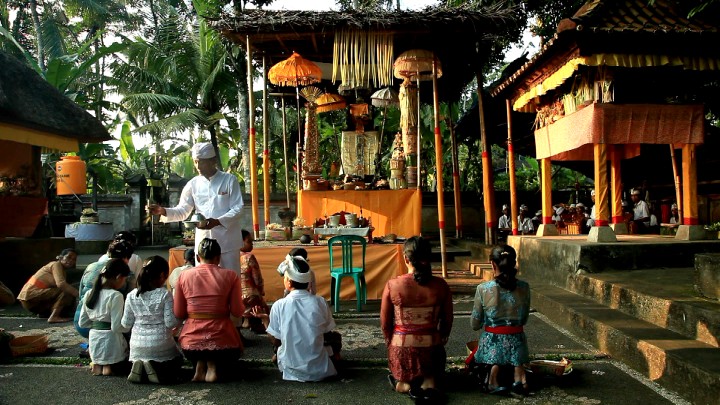
This is the "Pura Pasar Agung", dedicated to Prosperity As we have seen, it is the third of three temples right next to each other. We asked Wayan Sunantara, the leader of the village, whether there is a connection between the three temples. Wayan Sunantara: Certainly there is a link between these temples. This is Pasar Agung temple, dedicated to Prosperity. Right next to it, we have Melanting temple, the market temple, dedicated to the Goddess of Fertility. And at the lower level, we have the Merajapati temple that you saw first, dedicated to the guardian of the dead. So to sum up – this temple, Pasar Agung, is for birth, Pura Melanting is for life, and Pura Merajapati is for death. So these three temples relate to the concepts of birth, life and death. What about foreigners visiting the temple? We wondered whether foreigners are welcome to visit the temple during the festival. Here's what Pande Nyoman, a member of the temple, had to say... Pande Nyoman: If foreign visitors want to come to the temple and watch the ceremony, that's absolutely fine. There's just one condition: we believe that different kinds of clothes have different functions. So visitors really do need to wear proper Balinese costume. Then they are welcome to visit the temple and the festival. We also asked Wayan Sunantara, the leader of the village... Wayan Sunantara: Personally, I am happy to see visitors from overseas in the temple, I think it's a good thing. I welcome them, so can they understand our customs. But I always encourage visitors to do more than just take photos. I try to get them to understand the meaning behind what we do. If overseas visitors want to come here, perhaps it is because we can offer something that they can't find at home. I really think that if you want to find peace, Bali is the best place to do it – because in Bali we have developed special customs and rituals. And they can give you a sense of peace. 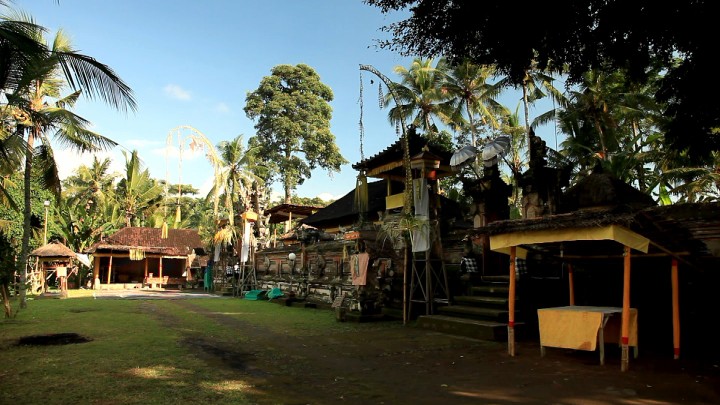
Thanks for reading! It's hard to get a feeling for what the temples are like just by looking at still pictures. So if possible, please visit our interactive film website, or watch our linear video about the temples. Click here to go to the interactive film version > Click here to see a video of the temples > Production Credits An interactive film by Martin Percy
Developed in conjunction with
For the Asian Art Museum:
Terima kasih kepada masyarakat desa Bedulu untuk kebaikan mereka
Concept, Camerawork, Edit, Interactive Direction: Martin Percy Interactive Production Company: unit9 Lead Designer: Billy Burgoyne
Tech Lead: Sergio Garcez
Producer: Richard Rowe
Female voice over: Tina Chiang
Jakarta Liaison: Reza Putraandana
Audio post production: Sound Disposition
At the Village of Bedulu, Bali:
Thanks also to:
Video © Martin Percy 2011 Exhibition Supporters Presentation at the Asian Art Museum is made possible by a grant from the National Endowment for the Humanities;
Lead funding for the Asian Art Museum's education and public programs is provided by the Bank of America Foundation.
|